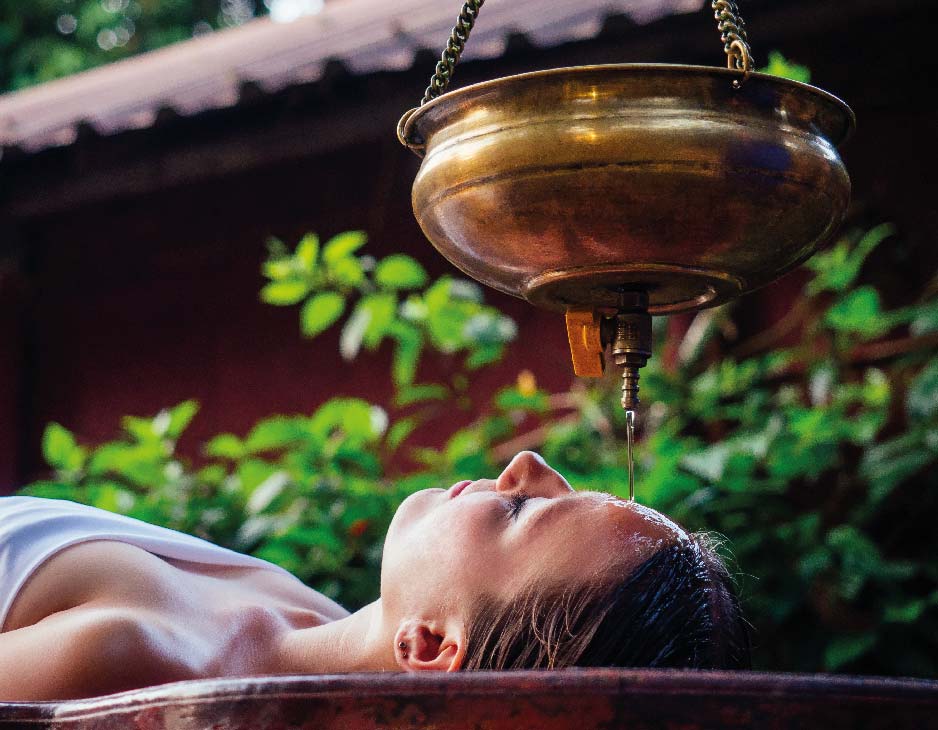Spa & Wellbeing
An Essential Guide to Ayurveda
31.03.2023

Ayurveda is a holistic ancient teaching advocating that each of us has a unique energy balance like a fingerprint. Originating more than 5,000 years ago in India, Ayurveda is considered the “Mother of All Healings”.
It bases its holistic approach on the delicate balance between our body, mind and spirit, which is completely unique to us, and the harmony of our self with the universe.
In our previous articles, we shared with you the Ayurvedic dosha types and the meaning of the term dosha. In this article, we approach the subject from a broader perspective and delve into the foundations of this virtuous healing science.
Ayurveda is a deep rooted traditional healing method that has been practiced for thousands of years. The term “Ayurveda” is derived from the Sanskrit words “ayus” (life) and “veda” (knowledge or science) and means “science of life”.
The reason why Ayurveda is called the science of life is that it deals with all physical, mental and spiritual aspects of life. As such, it takes a holistic approach to health and emphasizes the value of maintaining balance and harmony in all parts of our lives.
Ayurveda also recognizes that each individual is unique with his or her own unique constitution, or "Prakriti". It recognizes that each of us reacts differently to life events and has different strengths and weaknesses. And it wisely guides us with a wealth of knowledge based on our unique nature.

The origins of Ayurveda can be traced back to the Indus Valley Civilization of the second and third centuries BC. The principles of Ayurveda, which had been passed down through verbal traditions during this period, were written down in Sanskrit scriptures such as Charaka Samhita and Sushruta Samhita, which are considered to be the basic texts of Ayurveda with the arrival of the Vedic period.
Developing over centuries through insight and experience, Ayurvedic philosophy was influenced by various philosophical and spiritual traditions in India, such as yoga, tantra and Jainism, and incorporated new holistic approaches and therapies.
In the 18th and 19th centuries, the global dominance of Western medicine led to a decline in interest in traditional therapies, including Ayurveda. By the 20th century, however, Ayurveda’s popularity had grown rapidly again thanks to the emerging understanding as to how holistic and individual the concept of health is. Today, Ayurveda is recognized as complementary and alternative medicine in many countries and practiced by millions of people worldwide.
According to Ayurvedic philosophy, at the beginning of creation there was only an infinite nothingness. The universe and everything in it was born from the union of nature (Prakriti), the flowing feminine energy of creation, and consciousness (Purusha), the stable masculine energy of creation. The interaction of these two energies gave birth to the five basic elements (Pancha Maha Bhutas): space/ether (Aakash), air (Vayu), fire (Teja), water (Jala) and earth (Prithvi).
First, the tanmatra (subtle sound vibrations) of sound in space gave rise to the ether element. These dynamic vibrations gave rise to the element of air, and the friction of air in space generated radiance giving life to the element of fire. The interaction of fire with air and ether revealed the element of water, and the condensation of water with other elements created the element of earth.

Ayurveda uses the term “Guna” (quality, characteristic) to describe the corporeal states of these elements. For example, the air element is dry, thin and cold; the fire element is hot, sharp and light; and the water element is liquid, heavy and lubricious. All these qualities are grouped under the Trigunas in nature: Sattva, Rajas and Tamas. Sattva represents wisdom, balance and compassion; Rajas stands for movement, passion and excitement; and Tamas represents inertia, stagnation and darkness.
These five elements are also present in the human being (Prakti) and manifest in our body in three bio-energy (Dosha) patterns called Vata, Pitta and Kapha to allow the life energy (Prana) to flow freely in our being. The combination of ether and air forms Vata energy, the combination of fire and water forms Pitta energy, and the combination of water and earth forms Kapha energy. These Dosha types, known as Tridoshas, are present in the self in unique ratios yet in perfect balance. This is the basis of Ayurveda's teaching that each of us has a unique life energy.
If you would like to learn more about doshas, you can also take a look at our article “What is Dosha?”.
Vedic texts state that human beings are made up of three bodies (physical, mental and spiritual) that are interconnected and constantly exchanging energy and information. So, to speak of balance and harmony in our whole existence, we need to take care not only of our physical body, but also of our mental and emotional body. In this respect, Ayurveda is a holistic lifestyle guide that focuses on diagnosing and preventing diseases at their earliest stages, rather than “treating” them when they occur, as is done in Western medicine, and is dedicated to providing effective solutions for a lifetime.
Ayurveda is as individual as it is holistic... It considers that each individual has a unique dosha balance. Throughout our flow, this balance tends to be disturbed by many internal and external factors such as stress, physical and emotional trauma, dietary choices, seasons, work and family relationships. In order to regain balance, it is important to recognize the dominant dosha energies and understand the balance they create, within the self.
For a clearer understanding of your dosha energy balance and dominant doshas, you can refer to our article “Which Ayurvedic Dosha Body Type Are You?”.
According to this ancient science, which is based on the philosophy that ‘he/she who knows himself/herself can heal himself/herself’, for us to keep our doshas in balance throughout life, it is valuable to adopt a lifestyle that addresses all aspects of our life - physical, emotional and cognitive - from activities to self-care, from cooking techniques to nutrition. Below we share some key practices that can help us on this path:

Ayurvedic nutrition is a regimen that needs to be adapted depending on our dosha balance and imbalances. Because our dominant doshas can be thrown out of balance by ordinary (prakrita) and extraordinary (vaikruta) deviations, such as the seasons and the times of day. And this affects not only our physical aspects, but also our mental and emotional aspects.
Nevertheless, there are some rules we can follow to get closer to balance, no matter what our dominant dosha is... The first one is to consume local, seasonal and fresh foods, since unseasonal and processed foods can disrupt our dosha balance. Ayurveda also encourages mindful eating practices, such as eating at a measured pace in a calm environment, savoring every bite. It also emphasizes the value of right food combinations for optimal digestion and absorption of nutrients. This is because some foods, such as fruit and dairy products, can cause digestive problems when eaten together.
There is also value in paying attention to the flavors, spices and cooking methods that match our dominant doshas. Indeed, salty, sour, bitter, astringent and sweet foods have different effects on our being and taking them in the right proportion helps to balance the doshas.

Ayurveda advises us to incorporate and regularly practice daily self-care routines in tune with our dosha dominance. And it recommends that we all include in our lives skin care and massage with herbs and aromatic oils, meditative and yogic exercises and physical activities to clear our minds, calm our souls and rest our bodies. However, when it comes to which products and activities will bring us the highest benefit, Ayurveda again focuses on our unique dosha balance.
Pitta dosha types tend to have a fiery and intense nature. Accordingly;
can help Pitta doshas balance their intense energy.
Kapha types tend to be slower and more grounded, therefore;
can contribute to balancing their stagnant energy.
Vata doshas, on the other hand, are rather prone to a nervous and anxious nature. Thus;
can aid in stabilizing their vibrating energies.
Please note that the above are general recommendations based on dosha types. Since our dosha balance and dominance is completely authentic and unique to us, it is always valuable to first consult with an expert Ayurvedic counselor to determine as to which self-care practices would work best for us.

An important part of the Ayurvedic lifestyle is cleansing. Panchakarma is a comprehensive Ayurvedic detox program that aims to eliminate toxins and restore the balance of body, soul and mind. Tailored to each individual’s dosha balance and health needs, it can last anywhere from a few days to several weeks, and includes massage, herbal steam treatments and cleansing practices such as Virechana, Nasya and Raktamokshana.
In short, Ayurveda offers a comprehensive approach to health and well-being that can benefit many aspects of our lives. By adopting Ayurveda's approach that values our authentic selves and addresses our holistic being, we can grow closer to balance and harmony and embrace a healthier flow by reflecting it in our lifestyle...
The seven chakras are the seven instruments that uniquely orchestrate the energetic symphony of our being... They...
Read moreDeveloping a strong sense of wellbeing during the teenage years is one of the most valuable keys to living a...
Read moreThough much in the course of our lives is out of our control, the key to dealing with the uncertainties of the...
Read more